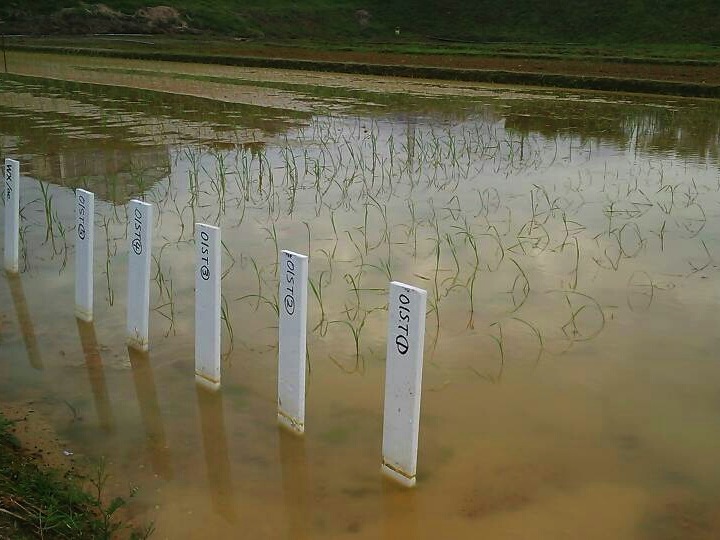FY2014 Annual Report
Plant Epigenetics Unit
Assistant Professor Hidetoshi Saze

Abstract
Our main goal in research is to understand epigenetic mechanisms for regulation of gene and transposon activities in the genomes of model plant systems such as Arabidopsis thaliana and rice, using genetic, biochemical and genomic methods. In addition, we are working on a research project called "functional Okinawan rice project” supported by Okinawa prefecture, in which we are producing a functional rice strain for Okinawa using molecular breeding techniques.
1. Staff
- Hidetoshi Saze, Assistant Professor
- Yuji Miyazaki, Researcher
- Ngoc Tu Le, Researcher
- Kenji Osabe, Researcher
- Yoshiko Harukawa, Technical Staff
- Saori Miura, Technical Staff
- Yasuka Shimajiri, Technical Staff
- Yoko Fujitomi, Research Administrator
- Nino Espinas, Student
- Tomohito Wauke, Student
2. Collaborations
- Theme: Analysis of intragenic transposable elements in plants
- Type of collaboration: Joint research
- Researchers:
- Prof. Shohei Takuno, Department of Evolutionary Studies of Biosystems School of Advanced Sciences, SOKENDAI
3. Activities and Findings
3.1 Epigenetic Regulation of intragenic transposable elements (TEs) in plants
We previously reported that in Arabidopsis thaliana, transcription of genes containing intragenic TEs requires a factor named IBM2 (Saze et al., 2013). IBM2 specifically recognizes TEs inserted in genic regions (intragenic TEs), but not intergenic TEs. We also found that intragenic TEs are often marked by repressive epigenetic modifications within actively transcribed regions.
To understand the distribution of intragenic TEs and their epigenetic regulation, we further analyzed TEs in the genome of Arabidopsis thaliana (Le et al., 2015). Our analysis revealed that about 3% of TEs are located within gene bodies, dominantly at intronic regions (Figure 1). Although intragenic TEs are shorter than intergenic TEs, they are still targeted by repressive epigenetic marks such as DNA methylation and histone H3K9 methylation. Counter-intuitively, the repressive state of intragenic TEs is critical for proper splicing and transcription of associated genes (Figure 2). Our results suggest the importance of epigenetic mechanisms for regulation of TEs within transcriptional gene units.

Figure 1: Abundance and classification of all TE (A) and intragenic TEs (B) in the A. thaliana genome. (C)-(F) TE length and family in intergenic and intragenic regions. P-values were given by the Mann-Whitney U test. (***) corresponds to P < 0.0005. Numbers inside bar plots indicate total numbers of TEs in each category. Error bars represent mean ± SE.

Figure 2: A model for epigenetic regulation of intronic TEs in A. thaliana. The heterochromatic state of intronic TEs is maintained by factors such as DDM1 and MET1. Proper splicing and poly-A tail formation are regulated by IBM2.
3.2 Okinawa functional rice project
Since FY2012, we have been working on the “functional rice project in Okinawa”, supported by the Research & Development Cluster program of Okinawa Prefecture. The rice strain, “Amiromochi,” accumulates digestion-resistant starch that is not readily catabolized to glucose. This trait could be useful to improve or prevent life-style-related diseases, such as obesity and diabetes, which are serious problems in Okinawa. Using molecular breeding techniques, we have backcrossed the Amiromochi strain several times to a local rice strain to replace the genetic background suitable for cultivation in Okinawa. The project has now progressed to the point of field tests at an experimental farm in Nago, Okinawa, where we are examining yields and other agricultural traits of the new rice strains (Figure 3). In parallel, animal experiments and human clinical trials for functionality of the functional rice are being conducted in collaboration with the University of the Ryukyus Hospital.

Figure 3: Field test of new rice strains bred in OIST, started in the first crop from January, 2015 at an experimental farm in Nago, Okinawa (photo taken on March 17, 2015).
4. Publications
4.1 Journals
- Le Tu N., Miyazaki Y., Takuno S., Saze H.† Epigenetic regulation of intragenic transposable elements impacts gene transcription in Arabidopsis thaliana. Nucleic Acids Res., doi: 10.1093/nar/gkv258, (2015).
4.2 Books and other one-time publications
Nothing to report
4.3 Oral and Poster Presentations
- (Invited talk) Saze H "Epigenetic regulation of transposable elements in plants" (Japanese). NIG meeting for "Reculateion of chromatin structures and genome function". National Insitute of Geneitcs, Mishima, Shizuoka, Japan, Oct 30-31, 2014.
- (Invited talk) Saze H. "Epigenetic regulation of intragenic transposon in Arabidopsis" (Japanese). The 126th meeting of Japanese Society of Breeding, Minami-kyushu university, Miyazaki, Japan, Sep26~27, 2014.
- (Invited talk) Saze H. "Epigenetic regulation of intragenic transposon in Arabidopsis" (English). The 86th Annual Meeting of the genetics society of Japan, Nagahama-bio, Shiga, Japan, Sep17~19, 2014.
- (Invited talk) Saze H. "Epigenetic Control of genes and transposable elements in Arabidopsis" (English) The 21st East Asia Joint Symposium on Biomedical Research. Samsung Medical Center, Seoul, Korea, July17~18, 2014.
5. Intellectual Property Rights and Other Specific Achievements
Nothing to report
6. Meetings and Events
6.1 Workshop
- The 37th Annual Meeting of the Molecular Biology Society of Japan
- Workshop "Impact of transposable elements on genome and epigenome dynamics"
- Organizers: Dr. Kenji Ichiyanagi (Kyushu U), Dr. Hidetoshi Saze (OIST)
- Date: Nov. 26, 2014
- Venue: Pacifico Yokohama, Japan.
6.2 Symposium
- International symposium: Okinawa R&D cluster program for functional rice project for prevantion and improvement of lifestyle diseases
- Dr. Hidetoshi Saze (OIST), Panelist.
- Date: Dec. 1, 2014
- Venue: ANA CROWNE PLAZA, Naha.
7. Other
Nothing to report.



